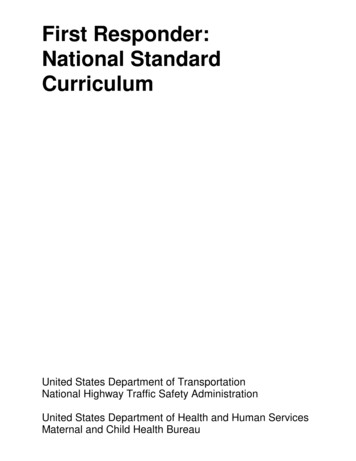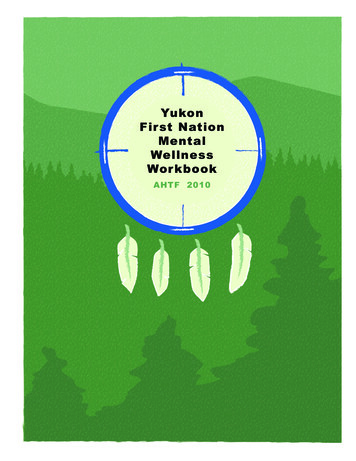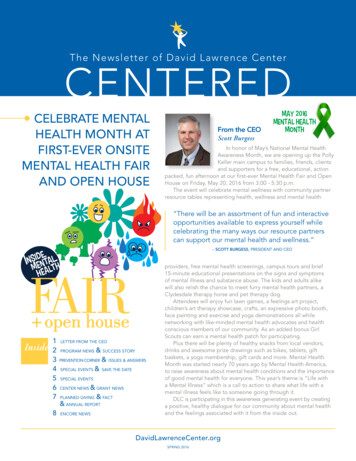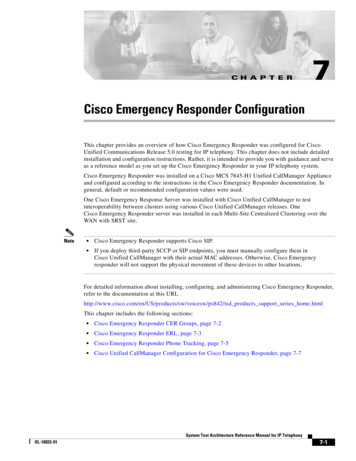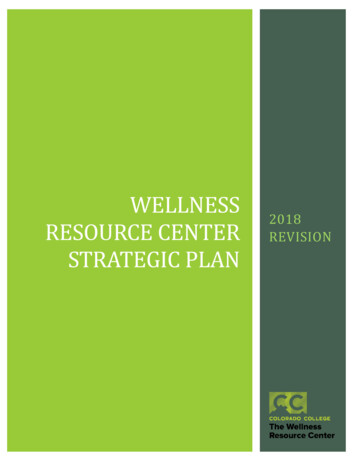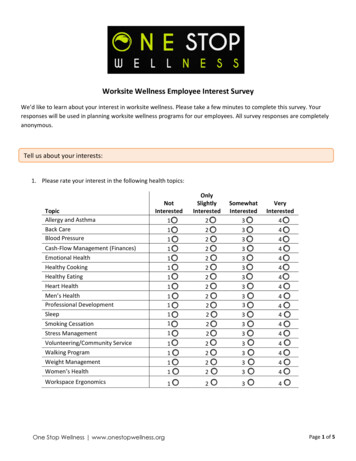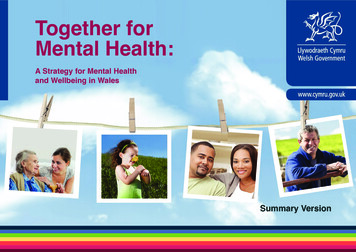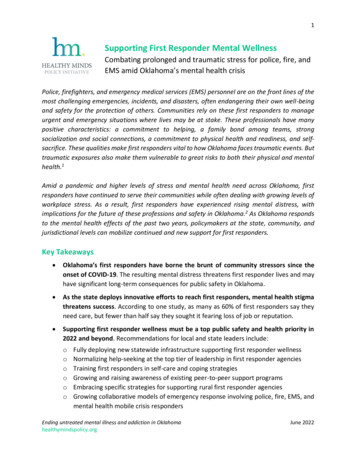
Transcription
1Supporting First Responder Mental WellnessCombating prolonged and traumatic stress for police, fire, andEMS amid Oklahoma’s mental health crisisPolice, firefighters, and emergency medical services (EMS) personnel are on the front lines of themost challenging emergencies, incidents, and disasters, often endangering their own well-beingand safety for the protection of others. Communities rely on these first responders to manageurgent and emergency situations where lives may be at stake. These professionals have manypositive characteristics: a commitment to helping, a family bond among teams, strongsocialization and social connections, a commitment to physical health and readiness, and selfsacrifice. These qualities make first responders vital to how Oklahoma faces traumatic events. Buttraumatic exposures also make them vulnerable to great risks to both their physical and mentalhealth.1Amid a pandemic and higher levels of stress and mental health need across Oklahoma, firstresponders have continued to serve their communities while often dealing with growing levels ofworkplace stress. As a result, first responders have experienced rising mental distress, withimplications for the future of these professions and safety in Oklahoma.2 As Oklahoma respondsto the mental health effects of the past two years, policymakers at the state, community, andjurisdictional levels can mobilize continued and new support for first responders.Key Takeaways Oklahoma’s first responders have borne the brunt of community stressors since theonset of COVID-19. The resulting mental distress threatens first responder lives and mayhave significant long-term consequences for public safety in Oklahoma. As the state deploys innovative efforts to reach first responders, mental health stigmathreatens success. According to one study, as many as 60% of first responders say theyneed care, but fewer than half say they sought it fearing loss of job or reputation. Supporting first responder wellness must be a top public safety and health priority in2022 and beyond. Recommendations for local and state leaders include:ooooooFully deploying new statewide infrastructure supporting first responder wellnessNormalizing help-seeking at the top tier of leadership in first responder agenciesTraining first responders in self-care and coping strategiesGrowing and raising awareness of existing peer-to-peer support programsEmbracing specific strategies for supporting rural first responder agenciesGrowing collaborative models of emergency response involving police, fire, EMS, andmental health mobile crisis respondersEnding untreated mental illness and addiction in Oklahomahealthymindspolicy.orgJune 2022
2High-Stress ProfessionsFirst responders are often the first people who respond to crisis situations that involve the harm,injury, or death of other community members, and these situations often pose a personal risk tothe first responders themselves. As such, first responders may experience a range of distressingevents. These include primary trauma (facing an event or experience that threatens themdirectly), secondary trauma (witnessing traumatic events that others experience), and moraldistress or injury (acting in or witnessing events that betray personal moral beliefs and valuesoccurring in high-stakes situations). Although the concept of moral injury is difficult to grasp forpeople outside of professions that involve life-and-death situations (such as first responder andmilitary service), it is notably a precursor to post-traumatic stress disorder and a factor inincreased suicide rates.3First responders receive extensive training in protecting themselves and others when faced withdangerous circumstances. They are screened for readiness and fitness for crisis response duties.However, rigorous physical and readiness training does not necessarily protect first respondersfrom elevated encounters with situations that stress their mental health. As a result, firstresponders have always been at higher risk for mental distress than the general population. Theinformation below summarizes research conducted prior to the pandemic.Police officers Police die at a proportionally higher rate from suicide compared to all other workers inthe U.S. working population.4 Studies find that police officers have higher rates of suicidecompared to the general public. Some experts suggest that studies relying on deathcertificate data underestimate the prevalence of suicides among police officers.5 A study of 193 U.S. active-duty officers found that 8.8% experienced suicidal ideation inthe prior two weeks;6 the 12-month average for U.S. adults reporting past-year suicidalideation at the time of the publication was 3.8%.7 Among police officers with higher depressive symptoms, increasing work hours wasassociated with greater prevalence of suicidal ideation.8 A study of police officer health disparities found the following health differences betweenpolice officers and workers in the general public:9o 12% of police officers had depression, compared to 6.8% of the employed generalpublic.o 33% of police officers reported that they typically slept fewer than 6 hours per day,compared to 8% of the employed general public. Insufficient sleep is often stronglyassociated with an increased risk of mental health problems.Ending untreated mental illness and addiction in Oklahomahealthymindspolicy.orgJune 2022
3Emergency medical services personnel 10% of emergency medical services personnel worldwide experience post-traumaticstress disorder (e.g., intrusive memories, nightmares).10 EMS personnel have a higher prevalence of post-traumatic stress disorder than does thegeneral population.11Firefighters Firefighters have a higher prevalence of suicidal ideation and behaviors compared to thegeneral population.12 A 2015 study surveyed nearly 1,000 firefighters from urban settings and found that morethan half had one or more heavy or “binge” drinking episodes in the past 30 days.13Worsening factors since 2020Since March 2020, first responders have worked in the context of an unprecedented globalpandemic that has led to rising mental health needs and trauma throughout Oklahoma. Findingshighlighted in previous Healthy Minds research show that Oklahoma has experienced:14 Rising anxiety and depression. Oklahoma’s rates of anxiety and depression during someperiods of the pandemic reached nearly four times higher than in 2019. Rising suicide rates. Between 2019 and 2020, the rate of deaths by suicide increasedmore than 8% statewide, with rural areas disproportionately accounting for this increase. Rising drug overdose fatalities. Overdoses climbed back to 2017 levels and are rising,with more than two years of improvements in the death rate erased. Fentanyl andsubstance use among individuals aged 25 and younger were among the drivers. Higher rates of unmet mental health need. For people who needed counseling, the rateof unmet need was highest in fall 2020, meaning that among people who neededcounseling, only about half received therapy.The findings reported here include first responder and their families, who have lived and workedin the same environments as all Oklahomans since the onset of the pandemic. However, unlikemost Oklahomans, first responders have experienced additional stressors related to thepandemic because 1.) they are essential workers who have had to continue serving the publicdespite the risks presented by COVID-19, and 2.) they face additional physical and emotionaldangers associated with being a first responder. The latter has arguably worsened during thepandemic as first responders have been exposed to physical danger and trauma as a result ofresponding to calls for service involving civilian suicides and overdose from substance use — allof which increased dramatically because of COVID-19.Ending untreated mental illness and addiction in Oklahomahealthymindspolicy.orgJune 2022
4For first responders during the pandemic, it is important to recognize three subgroups: 1.) thoseat higher-than-normal risk because of the physical health risks of COVID-19, 2.) responder-victimswho contracted the virus in the line of duty, and 3.) those who experience higher-than-normalstress because of the increased physical dangers to themselves (other than COVID exposure)from working in the current environment.15Absorbing the impact of a pandemicAs an essential workforce with increased exposure to the virus, first responders weredisproportionately affected by COVID-19. In perhaps the most unnerving example, 62% of allduty-related law enforcement officer deaths in 2020 nationally were a result of the virus, andCOVID-19 killed more law enforcement officers than any other single cause of death that year. 16Uncertainty about the virus, including fear of its risks, contributed to significant workplace stress,especially early in the pandemic. According to one early study, 55% of first responders and frontline health care providers reported being concerned about their mental health. 17 Similar findingsshowed that emergency personnel experienced higher than usual rates of diagnostic thresholds(14% for acute traumatic stress, 20% for depression, and 16% anxiety) compared to earlier serviceperiods.First responders also tended to experience the effects of social distancing policies more acutelythan did the general population. As one study noted, uniformed first responders were easy torecognize. They felt the public kept greater distance and isolation from them than from otherpeople. This isolation also came from co-workers and family members, which has led toadditional stress, depression, frustration, and stigma among first responders.18 These findings leda research team to claim that initial studies of traumatic stress, anxiety, and other stressorsplaced front-line and first responders at risk for psychiatric morbidity “at severity rates higherthan previous viral outbreaks and similar to previous disasters (e.g., 9/11 and HurricaneKatrina).”19Heightened depression, anxiety, and substance useRecent literature on the impact of the COVID-19 pandemic on first responders comes primarilyfrom studies completed in spring and summer 2020, a time of rapidly evolving and sometimesconfusing recommendations on safety precautions from the Centers for Disease Control andPrevention (CDC) and prior to vaccine availability. One such study included 401 firefighters and72 law enforcement personnel and used standardized screening instruments for acute traumaticstress, depression, anxiety, and risky alcohol use.20 In addition, this study examined insufficientsleep (fewer than 6 hours) and pandemic-related stressors (having direct engagement withinfected individuals).Ending untreated mental illness and addiction in Oklahomahealthymindspolicy.orgJune 2022
5These results of this study showed that: 14% had elevated acute traumatic stress 20% had elevated depression 16% had elevated anxiety 31% met criteria for risky alcohol use 23% met criteria for insufficient sleep 79% had direct contact with COVID-19 patients or people who likely had COVID-19Studies of EMS workers between June and August 2020 also found increased alcoholconsumption and severe symptoms of anxiety and depression.21 Another study of EMS and inhospital providers described first responders having “feelings of isolation, lack of support andunderstanding by family or friends, decreased or forced removal in immediate social interaction(e.g., within family and friend circles), sentiments of being infected or dirty, increased feelings ofsadness and anxiety, and reluctance to ask for help or get treatment (e.g., self-approval of beingisolated).”22These findings likely indicate that first responders experienced even higher levels of risk formental health and substance use problems in the early period of the pandemic. Because thegeneral public also experienced a much higher risk for behavioral health problems during thesame period, first responders have experienced compound stressors: their own personal risk forbehavioral health problems on top of daily interactions with a general public that is experiencinga higher frequency of life-threatening incidents. First responders getting help to manage theiremotional responses is crucial to their overall wellness and to their ability to provide emergencyassistance to the general population.Barriers to seeking helpDespite the higher rates of mental health and substance use problems among first responderscompared to the general public, barriers such as social or systemic stigma and self-stigma persist,preventing first responders from seeking treatment. 23 According to a 2021 study, of the 60% offirst responders reporting a need for care, less than half reported that they sought treatment. 24Many first responders feared that if they sought help, care will not be confidential or couldnegatively affect their career.25 Some were concerned about judgment or job discrimination bytheir peers and supervisors. In fact, an early pandemic survey found that 38% of first responderswere concerned about colleagues finding out they needed help, as compared to 28% of healthcare providers. First responders were equally concerned about their employer or supervisordiscovering a need for help.26Ending untreated mental illness and addiction in Oklahomahealthymindspolicy.orgJune 2022
6Other common barriers to care that first responders identified include challenges related toscheduling an appointment and not knowing where to get help. 27,28,29,30 To reduce these barriers,mental health programming for first responders should address systemic and internalized selfstigma, and peer-led interventions should be available to encourage first responders to seektreatment when needed.31,32A community example: Weathering a pandemicTo gain an on-the-ground perspective on the impact of the pandemic on first responders in oneOklahoma community, we interviewed representatives from the Tulsa police and firedepartments and from the First Responder Support Services organization, which providesconfidential counseling to first responders in the Tulsa area and some jurisdictions outside Tulsa.Everyone interviewed indicated that pandemic stressors have exacerbated existing conditionsand increased the need for mental health services. Personnel from the fire and policedepartments have substantially increased their utilization of counseling since the beginning ofthe pandemic.33As with the overall health care industry, many first responders had significant challenges withobtaining personal protective equipment. Absences resulting from the virus resulted in a lack ofpersonnel to fully respond to emergency situations. Improvements such as better access topersonal protective equipment, COVID-19-specific treatments, and vaccines and boosters helpedfirst responders with managing the pressures of the pandemic and their own health. But thewaves of COVID-19 infections continue with no apparent end in sight. The length of the pandemiccontributes to ongoing stressors and secondary trauma for first responders and the people theyserve.Interviewees and the literature also described first responders as having a special family-likebond with one another. This bond includes a strong socialization component, social connection,a group identity, self-sacrifice, and, sometimes, a sense of invincibility. 34,35 As the virus has takenits toll on the first responder workforce, requiring infected or potentially infected personnel totake leave to recuperate or quarantine, police and firefighters have had to cover additional shifts,further deregulating sleep and preventing full recovery from prior shifts. More recently, COVIDrelated deaths among colleagues in the force have resulted in many first responders grieving theloss of their own and questioning their sense of invincibility.Long-Term ImplicationsThe effects of compounding stressors and worsened mental health outcomes for first respondersare not always immediately recognizable, nor are the pandemic’s direct and indirect impacts fullyknown. Nonetheless, the combined traumas of the past two years may leave a lasting mark onEnding untreated mental illness and addiction in Oklahomahealthymindspolicy.orgJune 2022
7first responder professions and Oklahoma’s public safety moving forward. The threat of furtherloss of life among first responders, including suicide, is a top concern, particularly considering thelower rates of help-seeking for mental health conditions among certain first responders.Although more studies on the workforce and pandemic are needed, initial findings suggest thatpandemic stressors have contributed to both workforce and workplace issues. Some of theseissues were immediate, with one study showing that half of the health care workforce reportedbeing less likely to stay in their positions because of the pandemic. 36 A study of clinicians foundthat 19% reported retiring early or intending to retire early because of the pandemic; althoughfindings for clinicians do not directly apply to first responders, responses are likely similar.37 Asone observer noted, “health care staffing shortages are in and of themselves a COVID-19stressor.”38 As more first responders retired, resigned, or were removed from the front lines, thedecreased workforce had, and continues to have, increased negative effects on first responders’well-being and retention because of workforce shortages and having to cover extra shifts.Additional concerns surround the way all these stressors, if not adequately addressed, shapeboth how first responders and the people they serve are negatively affected. Especially duringthe peak periods of the pandemic, first responders experienced post-traumatic stress disorder(PTSD) at much higher levels than the general public did. The ongoing needs for PTSD supportand treatment are essential, given that initial findings show PTSD symptoms are especiallyprevalent among first responders and are the symptom most related to “adverse occupationaloutcomes.”39 Together, PTSD, sleep concerns, increased fatigue, workforce turnover, and othermental and physical health needs are likely to have ongoing effects for first responders. Theseconcerns are consistent with a pre-pandemic study finding that fatigue among first respondersendangered both personal health and safety, as well as the health and safety of the public andother responders.40Moreover, instances of moral injury may increase at times of heightened community andworkplace stress for first responders. Reporting on the experiences of first responders, a leadingpublication for fire and rescue professionals states that moral injury occurs when a leader“violates what is believed to be right in a high stakes situation” or when an individual“perpetuates, fails to prevent, bears witness to, or learns about an act that transgresses deeplyheld moral beliefs.“41 The results of moral injury can affect work performance and overall safety,as individuals experiencing moral injury may experience any of the following: “feelings of guilt, shame, anger, sadness, anxiety, and disgust; intrapersonal outcomes, including lowered self-esteem; high self-criticism; beliefs aboutbeing bad, damaged, unworthy, or weak; and self-handicapping behaviors;Ending untreated mental illness and addiction in Oklahomahealthymindspolicy.orgJune 2022
8 interpersonal outcomes, including loss of faith in people, avoidance of intimacy, and lackof trust in authority figures; and existential and spiritual outcomes, including loss of faith in previous religious beliefs, andno longer believing in a just world.”42,43Recommendations and Policy ConsiderationsSystems of supports for the mental health of first responders have developed over the years inrecognition of the stressors they experience on a day-to-day basis and the heightened or extremetrauma experienced in life-threatening critical incidents. These mental health supports includeemployee assistance programs and trauma-specific services for post-traumatic stress disorder.In recent years, the availability of peer supports has become more common. In these supports,officers are selected to receive training in recognizing mental health symptoms in peers, engagingin supportive discussions with their coworkers, and offering referrals when indicated. However,it is not clear whether these resources are well utilized among first responders. Low utilizationmay have several causes, such as stigma related to mental health and substance use conditionsand a sense of invincibility among first responder teams.During the pandemic, it became increasingly important to strengthen and expand these mentalhealth supports. Below are policy recommendations for addressing the needs of first responders.1. Fully deploy and sustain statewide infrastructure designed to support first respondersOklahoma is building on its infrastructure to support the wellness of first responders, mostnotably for police. The Oklahoma Department of Mental Health and Substance Abuse Services(ODMHSAS) implemented a program that provides confidential telehealth access for lawenforcement officers to mental health professionals using iPads. Through these devices,officers from participating agencies can reach out to debrief after critical incidents or processtheir day-to-day experiences with clinicians. However, utilization could be improved withcontinued enhancements, including 1.) ensuring this service includes options for first respondersto connect with support outside of the local area to increase utilization and reduce stigmabarriers, 2.) ramping up collaboration with specific police agencies whose officers may haveconcerns about utilizing the service, and 3.) providing resources to ensure connectivity of thetechnology every time it is deployed. Experts emphasize that utilization of these services issignificantly influenced by agency leadership who demonstrate support for officers seeking help.This iPad service could also be made available to other first responder groups.Additionally, the Oklahoma Legislature recently passed SB 1613, which authorizes a MentalWellness Division within the Department of Public Safety. This important policy step allows for asafe and confidential service for public safety personnel to seek help when needed. A smallEnding untreated mental illness and addiction in Oklahomahealthymindspolicy.orgJune 2022
9amount of funding — 150,000— was appropriated in the 2022 state budget for this purpose.Because of this, Oklahoma has the opportunity to broaden and deepen this state-of-the-artinitiative, expanding this type of service to other first responder agencies at the state level andsupporting its dissemination to county and municipal governments in support of their front-linepersonnel. Increasing access to direct behavioral health services, both in-person and through theuse of telehealth, is a strategy that could put Oklahoma at the forefront nationally as a state thatcares for the mental wellness of its first responders.2. First responder leadership must deal directly with stigma about stress and its relationship tomental health challengesLeaders must clearly and directly encourage participation in self-care and mental health servicesand convey that seeking help is a valued strength in their respective organizations. Leadershipstorytelling and role modeling of experiences and positive mental health practices help dismantlestigma. Explicit protections of job safety and support for seeking mental health support shouldbe communicated. Leaders can specifically endorse the use of emerging support resources, suchas the ODMHSAS iPad system, for anonymous help-seeking by law enforcement officers.3. First responder leadership must continually assess the occurrence of incidents by peers,leaders, or the organization that may betray moral and ethical beliefs of their staff and theirorganizational valuesIncidents that staff view as betraying morals and ethics lead to perceptions of leadership failurewithin and above the organization. They also lead to perceptions that leaders appear to beuncaring or incompetent. Part of the assessment for moral injury should include monitoring sickdays for staff members who are physically well but need time off, the overall morale of theorganization, and the frequency of episodes when staff display contempt, anger, and disgust.Access to suicide prevention training and suicide assessments should also be available.4. Provide training to first responders in self-care strategies and how to recognize and managestress before it turns into distress and maladaptive coping strategiesStress is commonplace in the role of first responders and actually has the positive attribute ofpressuring individuals to change, adapt, and grow as they master skills to deal with newchallenges in their environment. However, prolonged and traumatic stress can sometimesoverwhelm a person’s ability to cope and manage effectively. At this point, the personexperiences distress, which can lead to anxiety, depression, and abuse of substances to mitigatethe discomfort. Recognition of one’s experience and adaptiveness to stress, as well as healthycoping skills to prevent distress, can be developed through training and practice.Ending untreated mental illness and addiction in Oklahomahealthymindspolicy.orgJune 2022
10For self-care, the Substance Abuse and Mental Health Services Administration (SAMHSA) has aResource Portal that includes training such as Shield of Resilience (for law enforcement) andService to Self (for firefighters and EMS). The International Association of Fire Fighters alsooperates the Center of Excellence for Behavioral Health Treatment and Recovery, which offerstreatment for post-traumatic stress disorder and connects fire fighters to other mental healthresources.5. Provide employee assistance programs and first responder-specific support services todepartment staffFire and police departments can make one or both services available to staff and encourage theiruse for preventing and treating mental health disorders. To facilitate access and utilization, theseservices should be readily available, free, and confidential. In contracting for these services, it isimportant to verify that the provider organization staff are trained and utilize evidence-basedpractices for treating anxiety, depression, and post-traumatic stress disorder. These practicesinclude cognitive behavioral therapy, cognitive processing therapy, and eye movementdesensitization and reprocessing. Because mental illness affects relationships, services should beavailable, either through marital or family counseling, to spouses and others who live with andsupport first responders.6. Develop peer support programs within each departmentPeer support programs train and support selected front-line personnel to recognize behaviorsthat indicate a fellow first responder may be struggling to cope. Peer support personnel aretrained to engage with and discuss what the fellow first responder is experiencing. Peer supportstaff can share their own experiences and can encourage their peers to examine their situationand seek professional help when needed. Peer-focused interventions may be preferred overother types of interventions because peers understand the nature of the work and are trustedmore than professionals.44 Developing peer support programs serves to embed peer supportstaff within the force where they can be readily available when needed. Peers in support mustbe allowed to provide this service as part of their routine workday and not as an extra dutywithout pay. Department leadership must also support and encourage its use.Local peer support programs and resources: Warriors Rest Foundation has resources across Oklahoma to mentor and train peersupport teams to help first responders and their families.45 ODMHSAS provides Mental Health First Aid for First Responders and online suicideprevention training through LivingWorks Start.National exemplars of peer-led interventions:Ending untreated mental illness and addiction in Oklahomahealthymindspolicy.orgJune 2022
11 REACT (Recognize, Evaluate, Advocate, Coordinate, and Track) is a paraprofessionalprogram that trains first responders to provide peer support. Research suggests thatcolleagues trained in this program were better equipped to talk to peers about mentalhealth and to encourage seeking treatment.46 Firefighter Behavioral Health Alliance, run by former and current first responders,provides behavioral health workshops to firefighters and EMS personnel to increasebehavioral health awareness and promote available resources. The alliance educatespersonnel on the signs and symptoms of behavioral health problems, communication,and confidentiality to promote good mental health and to prevent first responder deathsby suicide. Lifelines staffed by peers can provide confidential crisis or support services for firstresponders. These services can remove some of the barriers to reaching out for help.CopLine is an international law enforcement officers’ hotline staffed by retired officers.7. Adapt first responder support services and training approaches for rural departments withsmall numbers of personnel by collaborating across jurisdictionsFire and police departments in rural communities have small numbers of personnel on theirrespective forces. Pulling a member out of service for training or any other reason is difficult, asthat reassignment leaves the community under-staffed for public safety response. Thesecommunities also have limited access to nearby mental health services. These factors complicatethe cost and logistics of providing training for rural departments, which therefore must employstrategies and approaches different from their urban and suburban departments counterparts.To overcome these barriers, allocations of federal COVID relief funding should be considered toestablish a supportive infrast
o Training first responders in self-care and coping strategies o Growing and raising awareness of existing peer-to-peer support programs o Embracing specific strategies for supporting rural first responder agencies o Growing collaborative models of emergency response involving police, fire, EMS, and mental health mobile crisis responders
